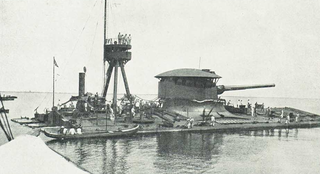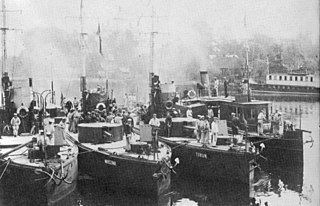 W
WA monitor is a class of relatively small warship that is lightly armoured, often provided with disproportionately large guns, and originally designed for coastal warfare. The term "monitor" grew to include breastwork monitors, the largest class of riverine warcraft known as river monitors, and was sometimes used as a generic term for any turreted ship. In the early 20th century, the term "monitor" included shallow-draft armoured shore bombardment vessels, particularly those of the Royal Navy: the Lord Clive-class monitors carried guns that fired the heaviest shells ever used at sea and saw action against German targets during World War I. Two small Royal Navy monitors from the First World War, Erebus and Terror survived to fight in the Second World War. When the requirement for shore support and strong shallow-water coastal defence returned, new monitors and variants such as coastal defence ships were built. Allied monitors saw service in the Mediterranean in support of the British Eighth Army's desert and Italian campaigns. They were part of the offshore bombardment for the Invasion of Normandy in 1944. They were also used to clear the German-mined River Scheldt by the British to utilize the port of Antwerp. The German, Yugoslav, Croatian, Romanian, Hungarian and Czech armed forces operated river monitors that saw combat during World War II.
 W
WThe Yugoslav monitor Drava was a river monitor operated by the Royal Yugoslav Navy between 1921 and 1941. She was originally built for the Austro-Hungarian Navy as the name ship of the Enns-class river monitors. As SMS Enns, she was part of the Danube Flotilla during World War I, and fought against the Serbian and Romanian armies from Belgrade to the lower Danube. In October 1915, she was covering an amphibious assault on Belgrade when she was holed below the waterline by a direct hit, and had to be towed to Budapest for repairs. After brief service with the Hungarian People's Republic at the end of the war, she was transferred to the newly created Kingdom of Serbs, Croats and Slovenes, and renamed Drava. She remained in service throughout the interwar period, but was not always in full commission due to budget restrictions.
 W
WThe Enns-class river monitors were built for the Austro-Hungarian Navy during the mid-1910s. The two ships of the class were assigned to the Danube Flotilla and participated in World War I. The ships survived the war and were transferred to Romania and the newly created Kingdom of Serbs, Croats and Slovenes as reparations.
 W
WFaà di Bruno was an Italian monitor built during World War I. Completed in 1917, the ship played a small role in the 11th Battle of the Isonzo later that year. She was decommissioned in 1924, but returned to service as the floating battery GM 194 at the beginning of World War II and was towed to Genoa and where she spent the rest of the war. The ship had her guns disabled when the Royal Navy bombarded Genoa in 1941. GM 194 was captured by the Germans after the Italian Armistice in 1943 and was turned over to the puppet Repubblica Sociale Italiana that they installed afterward. She was scuttled at the end of the war and subsequently scrapped.
 W
WSMS Körös was the name ship of the Körös-class river monitors built for the Austro-Hungarian Navy. Completed in 1892, the ship was part of the Danube Flotilla, and fought various Allied forces from Belgrade down the Danube to the Black Sea during World War I. After brief service with the Hungarian People's Republic at the end of the war, she was transferred to the newly created Kingdom of Serbs, Croats, and Slovenes, and renamed Morava. She remained in service throughout the interwar period, although budget restrictions meant she was not always in full commission.
 W
WNMS Mihail Kogălniceanu was a monitor of the Romanian Navy. She saw service in both world wars, being the most successful vessel in her class of four ships. Like her three sisters, she was initially built as a river monitor, but in early 1918, she was converted to a sea-going monitor. During the Second Balkan war, she supported the Romanian crossing of the Danube into Bulgaria. During World War I, she carried out numerous bombardments against the Central Powers forces advancing along the shore of the Danube and carried out the last action of the Romanian Navy before the 11 November 1918 armistice. She later fought successfully against Bolshevik naval forces during the early months of the Russian Civil War, helping secure the Budjak region. During the interwar period, she contributed to the suppression of the Tatarbunary Uprising and was rearmed with longer main guns towards the end of the 1930s. During World War II, she fought several engagements against the Soviet Navy in the first month of the Eastern Front, but was ultimately sunk by Soviet aircraft shortly after Romania ceased hostilities against the Soviet Union, on 24 August 1944.
 W
WParnaíba (U-17) [paʁnaˈibɐ] is a river monitor of the Brazilian Navy. She is currently the last monitor in service.
 W
WPresident Masaryk was a river monitor of the First Czechoslovak Republic, serving from 1932 until the dissolution of the republic in 1939. With four 66-millimetre (2.6 in) guns in two twin turrets, it was that nation's most powerful warship of the 1930s and flagship of the Czechoslovakian river flotilla. After the German occupation, the ship was taken into the German army under the name Bechelaren and fought against the Soviets. It was scrapped in 1978.
 W
WThe Yugoslav monitor Sava is a Temes-class river monitor that was built for the Austro-Hungarian Navy as SMS Bodrog. She fired the first shots of World War I just after 01:00 on 29 July 1914, when she and two other monitors shelled Serbian defences near Belgrade. She was part of the Danube Flotilla, and fought the Serbian and Romanian armies from Belgrade to the mouth of the Danube. In the closing stages of the war, she was the last monitor to withdraw towards Budapest, but was captured by the Serbs when she grounded on a sandbank downstream from Belgrade. After the war, she was transferred to the newly created Kingdom of Serbs, Croats and Slovenes, and renamed Sava. She remained in service throughout the interwar period, although budget restrictions meant she was not always in full commission.
 W
WThe Sava-class river monitors were built for the Austro-Hungarian Navy during the mid-1910s. The two ships of the class were assigned to the Danube Flotilla and participated in World War I. The ships survived the war and were transferred to Romania and the newly created Kingdom of Serbs, Croats and Slovenes as reparations.
 W
WVardar was a Sava-class river monitor built for the Austro-Hungarian Navy as SMS Bosna, but was renamed SMS Temes (II) before she went into service. During World War I, she was the flagship of the Danube Flotilla, and fought the Serbian Army, the Romanian Navy and Army, and the French Army. She reverted to the name Bosna in May 1917, after the original SMS Temes was raised and returned to service. After brief service with the Hungarian People's Republic at the end of the war, she was transferred to the newly created Kingdom of Serbs, Croats and Slovenes, and renamed Vardar. She remained in service throughout the interwar period, although budget restrictions meant she was not always in full commission.
 W
WORP Warszawa was an armed river monitor of the Riverine Flotilla of the Polish Navy, launched in 1920 and scuttled in 1939. She was raised by the Soviets, scuttled again in 1941, raised for the last time in 1944 and then scrapped.
 W
WORP Warszawa was an armed river monitor of the Riverine Flotilla of the Polish Navy, launched in 1920 and scuttled in 1939. She was raised by the Soviets, scuttled again in 1941, raised for the last time in 1944 and then scrapped.